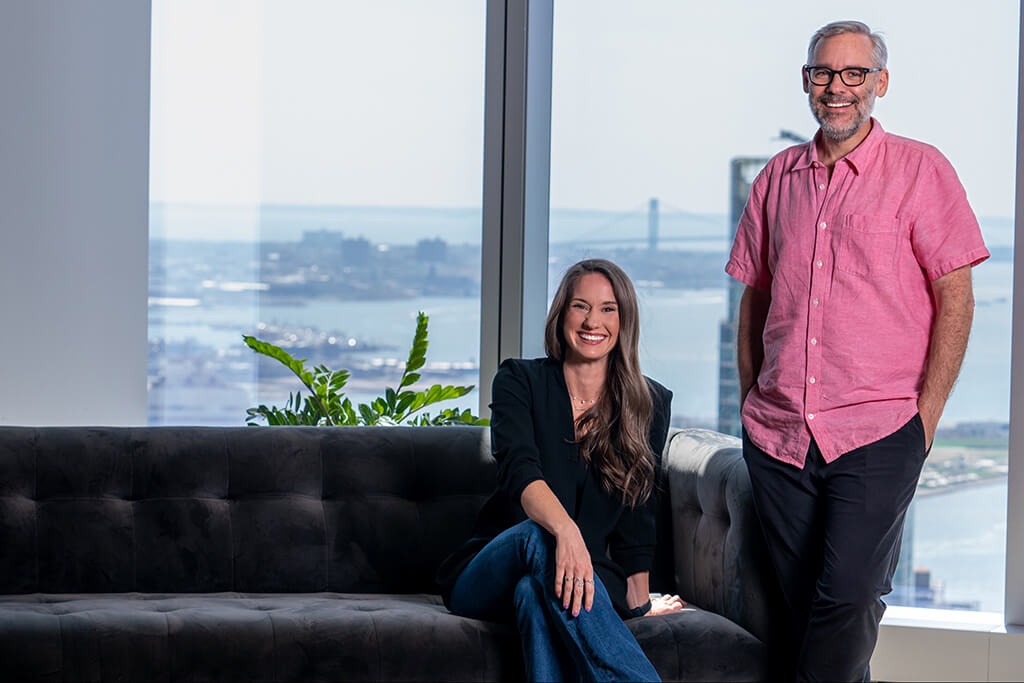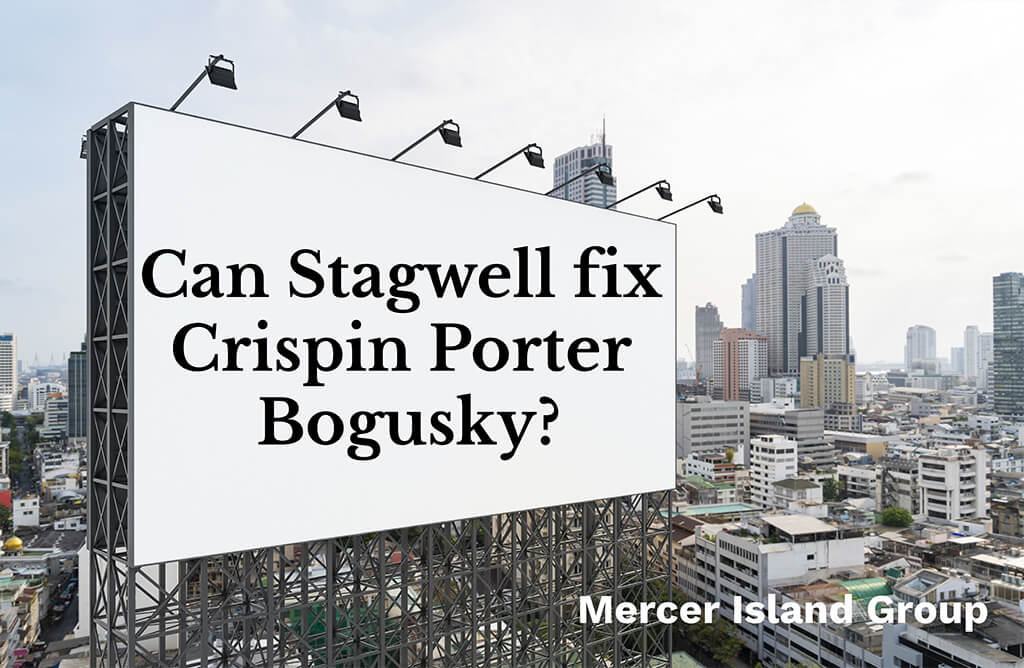Stagwell, the challenger brand holdco, has been on a roll.
Describing themselves as “The Challenger Marketing Network”, the holdco now has over 13,000 staff in 70 agencies across 34 countries. The roster includes highly awarded and well-regarded shops like 72andSunny, Anomaly, Assembly and Doner.
And now Stagwell may be taking on its greatest challenge: breathing new life into Crispin Porter Bogusky. Once one of the most successful and revered agencies in the world, Crispin Porter Bogusky has declined from around 800 staff to roughly 50 today. The plan is to merge Crispin’s 50 staff with media agency MMI (175 staff), creative shop Vitro (80 staff) and entertainment experts Observatory (45 staff). The new combination jumps Crispin from quite small to a solid mid-sized (300+ staff) agency with deep capabilities.
Will this work? Can Crispin Porter Bogusky be saved?
The Fall of Crispin Porter Bogusky
Founded in 1988, Crispin Porter Bogusky was once one of the most successful and acclaimed agencies in the world, contending with agencies like Wieden & Kennedy for the best creative reputation. The agency was named “Agency of the Year” over a dozen times in the trade press, including Agency of the Year acclaim by Adweek and Creativity. The agency was named Agency of the Decade by Advertising Age in 2009. The agency won a ton of major awards at Cannes. A series of big-name talent led the agency including Alex Bogusky, Chuck Porter, Erik Sollenberg, Andrew Keller and others. They achieved acclaim for viral marketing techniques, including the Burger King Subservient Chicken and Whopper Sacrifice campaigns. Agency headcount peaked at around 800.
Most of this success came before Stagwell acquired Crispin Porter Bogusky as part of the MDC acquisition. Prior to the acquisition, the agency went through a series of large client losses and leadership churn. By the time of the acquisition, CPB was a shell of its former self. Today, the agency has roughly 50 staff on the heels of a hard fall over a number of years.
The New Crispin Porter Bogusky & the Path Forward
The new Crispin Porter Bogusky includes a series of agencies that have been on quite a roll.
To better understand the path forward, we reached out to Crispin Global CEO Brad Simms, who is also the CEO of GALE, and Crispin Chief Growth Officer, formerly the CEO of Vitro, Tom Sullivan.
Brad has been busy! He’s led GALE to this year’s Ad Age A-List and Adweek’s Breakthrough Media Agency of the Year and the agency has won a series of impressive clients. He’s also one of the architects of the Crispin Porter Bogusky relaunch. Tom has been busy collaborating with MMI, Crispin and Observatory while leading the pirates at Vitro. We caught up with Brad and Tom in the midst of the merger to answer some of our pressing questions.

New Crispin Porter Bogusky North America CEO Maggie Malek and Global CEO Brad Simms
You’re approaching Crispin differently than many holdcos have approached legacy agency brands that have fallen on hard times. Why?
Brad: Few agencies can claim to have changed the trajectory of the advertising industry in the way that Crispin can. Crispin fundamentally changed the way we thought about advertising by blending the lines of creative and media and placing earned at the core of every idea. It was transformative then and with the rising demand for integrated solutions from modern marketers, we see this unique combination of capabilities as transformative again today.
This is not a traditional top-down mandate from a holding company, but a bottom-up approach supported by Stagwell as a strategic move in the marketplace. Crispin, MMI, Vitro and Observatory combining forces has been driven by the leaders of each agency after seeing a natural alignment of capabilities both on new and existing clients over the last six months.
At Stagwell and within the Brand Performance Network, we have always been focused on building the agency structure and operating models that the market wants and our clients need. It’s not about what works for us as a holding company but instead where we can prioritize creating greater offerings and stronger, more seamless solutions for our clients.
People have a sense of what Crispin was years ago. They probably have less sense of what is has been recently. What will it be in the future?
Brad: Crispin has a long history of unbelievable work. This move reclaims Crispin’s transformational DNA, by integrating MMI’s media and performance marketing, Vitro’s boutique creative and Observatory’s branded entertainment capabilities to create an integrated creative powerhouse. Crispin is now a 300-strong agency across North America, bringing together diverse expertise and capabilities under one roof. We’re bullish about its future because we know that combined services are the makings of a competitive modern agency.
MMI, Vitro, Observatory and Crispin each bring something different to the party. What is most important about each piece that becomes the new Crispin?
Tom: The move brings together the power of four sets of complementary, like-minded and modern ingredients. MMI brings media and performance marketing, Vitro brings boutique creative, and Observatory offers branded entertainment capabilities. Through our work together on existing clients, including Wells, NRG, Country Financial and P&G, and new business opportunities, we’ve found this unique combination is incredibly compelling.
You’re combining these four brands into something new at a time of great change across the industry. How will the new Crispin meet the needs of the marketplace?
Brad: Clients are looking for right-sized agencies that have integrated capabilities. Agencies that are too small don’t have depth and breadth. In agencies that are too large, clients get lost. We believe the size of the new Crispin brings the balance between these two.
Putting together different agencies with different cultures and skillsets is a tall order. What is the key to making this combination work?
Brad: Key to combining the forces of these agencies is the six months of collaboration between Crispin, Vitro, MMI and Observatory before the decision. This formalizes a natural alignment in capabilities, culture and ambition. Newly appointed President, North America Maggie Malek recently oversaw the successful integration of Media Kitchen into MMI with 100% employee and client retention and will no doubt lead this next chapter for Crispin with the same effectiveness.
This is being driven by the agencies, not the hold company. This is not a story of “efficiencies” like we often see in adland. This is about accelerating and enabling growth.
What kinds of clients are ideal for the new Crispin?
Brad: Modern marketers who are seeking simplicity, integration, and breakthrough creativity.
Will This Work?
I asked Jae Goodman, founder and former CEO of Observatory (Fast Company’s Most Innovative Companies list 3X!) about this merger and he said:
“The strength of the individual entities is amazing. And Maggie Malek is a remarkable leader and modern marketer, and Linda Knight (CCO, Observatory) is one of for most forward-thinking creative leaders in the world – the right people working together at the right time. Plus Mark Penn has an acute sense of what the market wants. The market should bet on this working.”
Mercer Island Group’s Advice
Turning around a troubled agency brand like Crispin Porter Bogusky is a giant challenge and if successful will be a deservedly proud accomplishment for Crispin leadership like Brad Simms, Maggie Malek and Tom Sullivan and their entire team. We think there are a handful of key priorities that will be needed to make sure Crispin has the best chance at succeeding:
- Get the positioning right: The new Crispin Porter Bogusky will have a different set of capabilities than the Crispin Porter Bogusky of old. Modernizing the brand while still keeping a connection to the best of the Crispin of yesteryear will be critical.
- Create a new culture that is the foundation for success: Merging four agencies is no small task. And creating a culture that employees want to work in, and clients want to work with, may be the most challenging aspect of this adventure. The new agency needs to be proud without the arrogance of the peak reputation shop.
- Great strategy, creative, media and data science leadership that works in partnership: The market wants this. The new organization has been designed to deliver this. But it has to be a brilliant partnership and not competing silos or fiefdoms.
At MIG, we’ll be rooting for this to work. We love agencies and this industry and hate to see great brands disappear. Good luck to Brad, Maggie, Tom and company!
Steve Boehler, founder, and partner at Mercer Island Group has led consulting teams on behalf of clients as diverse as Zillow Group, Microsoft, UScellular, Nintendo, Ulta Beauty, Stop & Shop, Qualcomm, Brooks Running, and numerous others. He founded MIG after serving as a division president in a Fortune 100 when he was only 32. Earlier in his career, Steve Boehler cut his teeth with a decade in Brand Management at Procter & Gamble, leading brands like Tide, Pringles, and Jif.
